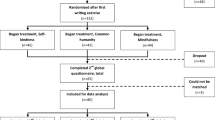Abstract
Previous research indicates that sympathy for victims is related to how much they are suffering. Yet, it is unclear whether greater suffering alone leads to more compassionate reactions to victims or whether reactions to victims are moderated by other factors such as the duration of the suffering or the perceived frequency of the occurrence that causes suffering. Using Kelley’s (Neb Symp Motiv 15:192–238, 1967) covariation model as our theoretical framework, our study tested whether severity and number of misfortunes affected reactions to a target claiming to be a victim. Participants evaluated a target after viewing one of the four video interviews. The videos manipulated the severity and number of misfortunes claimed by a victim. More misfortunes generated more helping intentions. Severe misfortunes generated stronger empathic reactions to victims, whereas minor misfortunes generated stronger negative appraisals of victims. However, number of misfortunes moderated this effect: The most negative reactions were elicited by claims of many minor misfortunes and the most positive reactions by claims of many severe misfortunes. Additionally, participants were more likely endorse helping intentions in response to claims of many severe misfortunes than claims of many minor misfortunes. These results provide insight into factors influencing whether people are taken seriously as victims.


Similar content being viewed by others
References
Aiken, L. S., West, S. G., & Reno, R. R. (1991). Multiple regression: Testing and interpreting interactions. Beverly Hills: Sage.
Batson, C. D., Early, S., & Salvarani, G. (1997). Perspective taking: Imagining how another feels versus imagining how you would feel. Personality and Social Psychology Bulletin, 23, 751–758.
Batson, C. D., O’Quin, K., Fultz, J., Vanderplas, M., & Isen, A. M. (1983). Influence of self-reported distress and empathy on egoistic versus altruistic motivation to help. Journal of Personality and Social Psychology, 45, 706–718.
Campbell, B., & Manning, J. (2014). Microaggression and moral cultures. Comparative Sociology, 13(6), 692–726.
Christie, N. (1986). The Ideal Victim. In E. A. Fattah (Ed.), From Crime Policy to Victim Policy. London: Palgrave Macmillan.
Clements, C., Brannen, D., Kirkley, S., Gordon, T., & Church, W., II. (2006). The measurement of concern about victims: Empathy, victim advocacy and the victim concern scale (VCS). Legal and Criminological Psychology, 11, 283–295.
Coke, J. S., Batson, C. D., & McDavis, K. (1978). Empathetic method of helping: A two-stage model. Journal of Personality and Psychology, 36(7), 752–766.
Croyle, R. T., & Ditto, P. H. (1990). Illness cognition and behavior: An experimental approach. Journal of Behavioral Medicine, 13(1), 31–52.
Glenton, C. (2003). Chronic back pain sufferers—striving for the sick role. Social Science and Medicine, 57(11), 2243–2252.
Harris, A. J., Corner, A., & Hahn, U. (2009). Estimating the probability of negative events. Cognition, 110(1), 51–64.
Kelley, H. H. (1967). Attribution theory in social psychology. Nebraska Symposium on Motivation, 15, 192–238.
Kowalski, R. M. (2002). Whining, griping, and complaining: positivity in the negativity. Journal of Clinical Psychology, 58(9), 1023.
Monin, J. K., & Schulz, R. (2009). Interpersonal effects of suffering in older adult caregiving relationships. Psychology and Aging, 24(3), 681–695. https://doi.org/10.1037/a0016355.
Small, D., Loewenstein, G., & Slovic, P. (2007). Sympathy and callousness: The impact of deliberative thought on donations to identifiable and statistical victims. Organizational Behavior and Human Decision Processes, 102, 143–153.
Van Dijk, J. (2009). Free the victim: A critique of the western conception of victimhood. International Review of Victimology, 16(1), 1–33.
Van Dijk, J. (2013). Who is the ‘little old lady ‘of international crimes? Nils Christie’s concept of the ideal victim reinterpreted. International Review of Victimology, 19(2), 159–179.
Weber, E. U., & Hilton, D. J. (1990). Contextual effects in the interpretations of probability words: Perceived base rate and severity of events. Journal of Experimental Psychology: Human Perception and Performance, 16(4), 781.
Author information
Authors and Affiliations
Corresponding author
Ethics declarations
Ethical Standard
All procedures performed in studies involving human participants were in accordance with the ethical standards of the institutional and/or national research committee and with the 1964 Helsinki declaration and its later amendments or comparable ethical standards.
Additional information
Publisher's Note
Springer Nature remains neutral with regard to jurisdictional claims in published maps and institutional affiliations.
Rights and permissions
About this article
Cite this article
Lewis, J.A., Hamilton, J.C., Dean Elmore, J. et al. The Effects of Severity and Number of Misfortunes on Reactions to Victims. Soc Just Res 32, 445–458 (2019). https://doi.org/10.1007/s11211-019-00338-4
Published:
Issue Date:
DOI: https://doi.org/10.1007/s11211-019-00338-4




